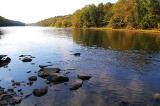Conservation Overview
West Virginia, sparsely populated and heavily forested, is a relatively small state, but its far-reaching panhandles and rugged terrain provide ecological diversity beyond its size. The state spans the eastern continental divide, a barrier for migration and evolution of aquatic life, which has resulted in unique assemblages of fishes, mussels and crayfishes. The backbone of the high Allegheny Mountains also maintains a climatic gradient across the state, catching abundant precipitation on its western flanks and creating a rain shadow to the east.
Rare Species and Characteristic Habitats
The humid, hilly-to-mountainous, western two-thirds of the state are at the center of the mixed mesophytic forest region. Its climax deciduous forests host a high concentration of plant species with closest relatives in East Asia. Examples of these “disjunct taxa” include tuliptree, trumpet vine, blue cohosh and ginseng. West Virginia animals with similar East Asian counterparts include hellbenders (two-foot long aquatic salamanders), copperhead snakes and paddlefish. These ancient lineages became separated millions of years ago after the breakup of the Pangaea supercontinent and subsequent mountain building and climate change created vast areas of unsuitable intervening habitat.
Prior to the logging boom around the turn of the 20th century, a vast boreal-like red spruce forest predominated on Allegheny Mountain slopes above 3000 feet; smaller patches remaining today are slowly expanding into their previous range. The spruce zone also contains headwater wetlands that contain some of the highest concentrations of rare plants in the state. These high forests provide homes to the endemic Cheat Mountain salamander and the globally rare West Virginia flying squirrel.
To the east, the Ridge and Valley region provides additional habitat diversity. Dramatic folding and uplift followed by erosion created the topography of parallel ridges and valleys with alternating exposures of shale, sandstone and limestone, each displaying its own vegetation. Oak-hickory, oak/heath and oak-pine forests and woodlands are prominent in this relatively dry region. Underneath karst topography formed in limestone, extensive caves provide habitat for some of the richest assemblages of subterranean fauna in the world, including endemic isopods, amphipods, springtails and beetles.
Public and Private Conservation Efforts
Public conservation lands cover about 11 percent of the state. The largest areas were established as National Forests in the 1920s in response to the habitat destruction of the logging boom. More recently, three National Park units were established to protect the gorges of the New, Gauley and Bluestone Rivers, and the Canaan Valley National Wildlife Refuge was established to protect the largest complex of high-elevation wetlands in the eastern United States. The Nature Conservancy has been instrumental in acquiring conservation lands and transferring them to public ownership, as well as maintaining several of its own preserves. The West Virginia Natural Heritage Program, established in 1975 within the Division of Natural Resources, gathers, maintains, and distributes data on the state’s biological diversity to help focus conservation efforts on the most deserving species, communities and sites.
Threats
West Virginia’s impressive biological diversity faces numerous threats. Coal mining has had especially devastating effects on aquatic species, and coal-fired power plants are major sources of greenhouse gases and acid deposition. Recently proliferating windmill farms are killing bats and birds. Pipelines and power transmission corridors dissect our forests, and more are proposed to meet the nation’s increasing demands for energy. Second homes are creating rural sprawl and fragmenting large forest blocks. Hemlock forests are currently disappearing in many parts of the state due to a tiny exotic insect pest. Invasions of exotic weeds such as Japanese stiltgrass and garlic mustard are out-competing native understory herbs. Heavy browsing by large populations of white-tailed deer threatens rare plants and forest regeneration in many areas.
West Virginia’s Future
West Virginia offers hope in the face of these regional threats. Our large blocks of forest continue to provide refuge for plants and animals that are declining rapidly elsewhere. In the future, these populations may serve as a source for genotypes pre-adapted to a warming climate, and our rivers and mountains may once again serve as migration routes.







